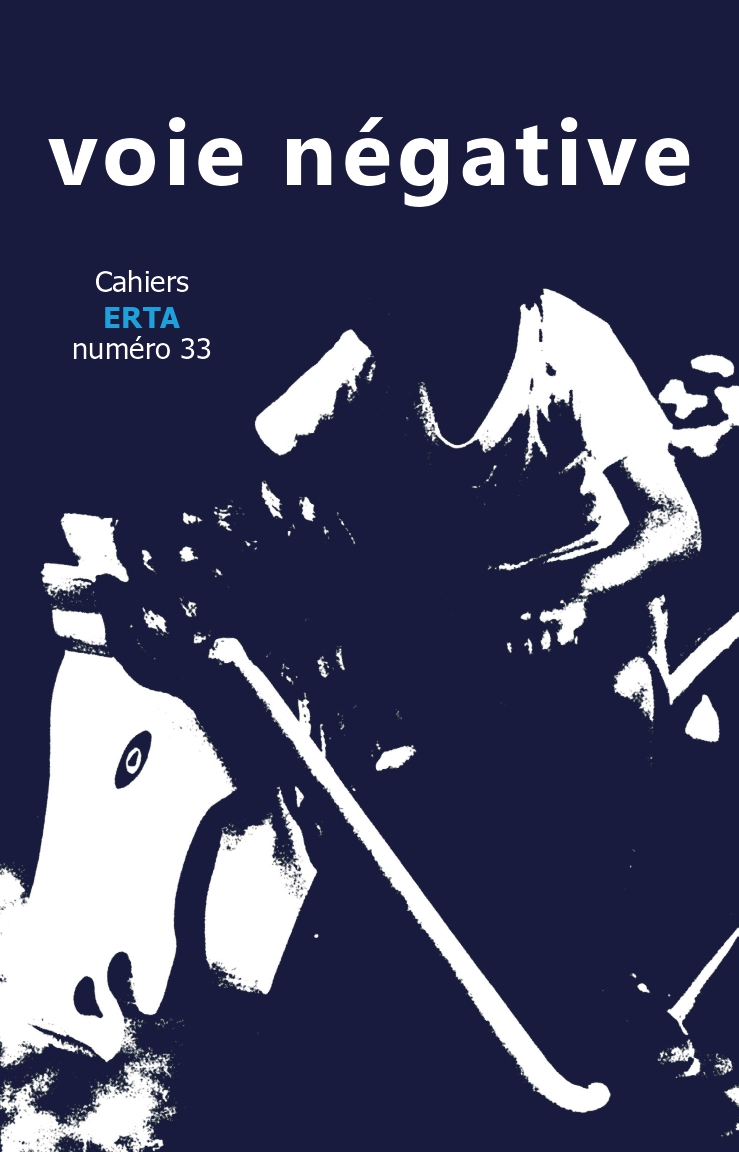Apophatisme et non-dualité dans le "Vedānta" et chez Ad Reinhardt
Mots-clés :
apophase, abstraction, indifférenciation, désimagination, insignifiance, non-dualitéRésumé
The Ultimate Paintings, a series of abstractions made by Ad Reinhardt during the 1960s, are coupled with writings with obvious affinities to the apophatic formulas of the commentaries of the Upanishads (the philosophical conclusions of the Vedas) known as the “nondual Vedānta” (Advaita Vedānta). The abstractions themselves refer to the model of the yantra, the geometrical diagram into which Brahmanic iconography is supposed to subside. In this instance, the apophasis defeats the attempt to signify through painting and language what constitutes itself in painting and language.
Téléchargements
Références
Andia Y. de, Denys l’Aréopagite. Tradition et métamorphoses, Paris, Vrin, 2006.
Aristote, Les seconds analytiques, J. Tricot (trad.), [dans :] Aristote, Organon, Paris, Vrin, 1987, t. 4.
Biardeau M., Théorie de la connaissance et philosophie de la parole dans le brahmanisme classique, Paris, La Haye, Mouton & Co., 1964.
Biardeau M., « Quelques réflexions sur l’apophatisme de Çankara », Indo-Iranian Journal, The Hague, Mouton & Co., 1959, vol. 3.
Boner A., Rath Śarma S., Bäumer B. (dir.), Vāstusūtra Upaniṣad. The Essence of Form in Sacred Art, Delhi, Motilal Banarsidass, 1996.
Coomaraswamy A. K., Hindouisme et Bouddhisme, R. Allard et P. Ponsoye (trad.), Paris, Gallimard, 1949.
Cush D., Robinson C., York M. (dir.), Encyclopedia of Hinduism, New York, Routledge, 2008.
Degrâces A. (dir.), Les Upaniṣad, Paris, Fayard, 2014.
Feuga P., Comme un cercle de feu. Māṇḍūkya-upaniṣad et Kārikā de Gauḍapāda, Paris, Accarias-L’Originel, 2004.
Guénon R., Orient et Occident, Paris, Éditions de La Maisnie, 1987.
Hadot P., Exercices spirituels et philosophie antique, Paris, Albin Michel, 2002.
Hulin M., Śaṅkara et la non-dualité, Paris, Bayard, 2001.
Khanna M., Yantra. The Tantric Symbol of Cosmic Unity, London, Thames & Hudson, 1979.
Masson-Oursel P., « Objet et méthode de la philosophie comparée », [dans:] Revue de Métaphysique et de Morale, 1911, n° 4.
Platon, Le Sophiste, N.-L. Cordero (trad.), Paris, Flammarion, 1993.
Reding J.-P., Les fondements philosophiques de la rhétorique chez les sophistes grecs et chez les sophistes chinois, Berne, Peter Lang, 1985.
Rose B. (dir.), Art as Art. The Selected Writings of Ad Reinhardt, Berkeley, University of California Press, 1991.
Sharma B. N. K., History of the Dvaita School of Vedānta and its Literature from the earliest Beginnings to our own Times, Dehli, Motilal Banarsidass, 1981.

 Revues scientifiques académiques
Revues scientifiques académiques





